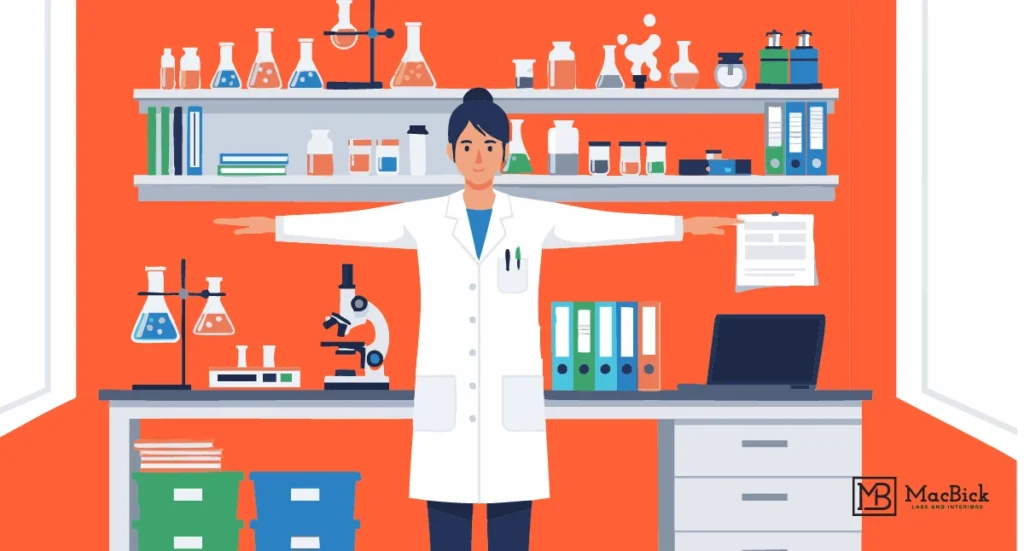Groundbreaking scientific research and discoveries happen in laboratories. However, a formidable challenge looms while conducting important research – space constraints in laboratories.
The significance of space optimization in laboratories cannot be overstated. It is the linchpin upon which the success of experiments, the flow of ideas, and the trajectory of scientific breakthroughs hinge. Every facet of lab design plays a pivotal role in shaping the research ecosystem – from the arrangement of equipment to the integration of collaborative spaces.
In this blog, we’ll explore practical and effective tips for optimizing space in small lab environments, providing you with strategies that can be implemented in your own lab.
Understanding the Importance of Space Efficiency in Small Laboratory Environments
Limited laboratory space hinders workflow, safety, and the potential for groundbreaking research. Therefore, space efficiency in small laboratory environments involves using limited space to optimize functionality. It’s maximizing the utility of every inch of space without compromising the ability to conduct research effectively. Here is the reason why space efficiency is essential in laboratory environments:
- Limited storage forces researchers to stack equipment or chemicals precariously, which creates safety hazards.
- Improper storage makes it difficult for researchers to access safety equipment quickly in an emergency.
- Small, cluttered labs can make it difficult for researchers to share ideas and work together effectively.
Tips for Optimizing Space in Small Laboratory Environments
You can keep your small laboratories organized and functional with the following tips. Let’s dive in!
Conduct a Thorough Assessment of Laboratory Needs
The first step towards optimizing spaces in the laboratory begins with understanding the small lab’s current and future needs comprehensively. This initial assessment should encompass the following:
- Take into account all the equipment, furniture, and other inventories used in laboratories. You should have a clear understanding of which items to clutter and declutter.
- Evaluate congested areas hindering workflow efficiency and explore strategic solutions for improved spatial organization.
- Research well and keep future considerations in mind to anticipate additional equipment placement and other storage spaces.
Formulate a Strategic Lab Layout Design
Once you have assessed your laboratory’s needs, formulate a strategic lab layout design to utilize spaces well. The layout design should include:
- Clear pathways for the smooth movement of researchers and scientists so they can easily use equipment and prevent accidents or inefficiencies.
- Dedicated zones separately for chemical handling, meetings and other tasks. It will keep everything organized in the laboratory space and minimize the need for researchers to move between different areas for functions.
- Positioning frequently used equipment and supplies in easy-to-reach areas to minimize wasted time and effort.
Leverage Modular Storage Solutions
Traditional cabinets didn’t make efficient use of the space in the small laboratories. Therefore, incorporating modular storage solutions can offer maximized space efficiency in small laboratories. You should consider incorporating modular storage solutions such as:
- Utilize vertical space with floor-to-ceiling cabinets to maximize storage capacity.
- Install adjustable shelving units to accommodate various equipment sizes and optimize vertical storage space.
- Employ cabinets for frequently accessed items for efficient workflow management.
Prioritize Ergonomic Considerations
You should prioritize ergonomic considerations to ensure that workstations are optimally designed to minimize strain and fatigue among scientists and researchers. Here’s how you can get a comfortable and safe work environment:
- Invest in height-adjustable benches to prevent repetitive strain injuries in researchers.
- Provide ergonomic chairs with good lumbar support to minimize fatigue and discomfort during extended work periods.
- Ensure proper lighting throughout the laboratory to reduce eye strain for researchers and scientists.
Equip the Lab with the Right Equipment
You should prioritize areas for frequently and infrequently used equipment to streamline accessibility and enhance organization efficiency. Consider these factors:
- Look for space-saving equipment that offers high performance with smaller footprints.
- Consider equipment that can be easily scaled up or down as your research needs evolve.
Implement Shared Workstations
Design shared workstations that optimize spaces effectively. It may include:
- Implement subtle visual dividers, such as low partitions or frosted glass panels, to provide a sense of personal space.
- Consider incorporating features like built-in power outlets, USB ports, and screen-sharing capabilities to facilitate seamless collaboration and data sharing.
Apart from this, you can incorporate small plants into the shared workspace to create a more inviting and refreshing environment. Moreover, a regular cleaning schedule should be established to maintain a tidy and hygienic workspace. You can create shared workstations that optimize space while fostering collaboration and promoting a positive working environment in your small laboratory.
Wrapping Up
Maximizing space efficiency in laboratory spaces requires careful planning. You can design a layout strategically and create a functional and safe lab environment. Moreover, you can keep yourself updated with the latest trends in lab design for space-efficient solutions. Staying informed will help you implement the best practices in your lab and enhance overall productivity.
Ready to optimize your small lab’s space for maximum efficiency? Contact MacBick Labs and Interiors today and unlock the full potential of your workspace!


